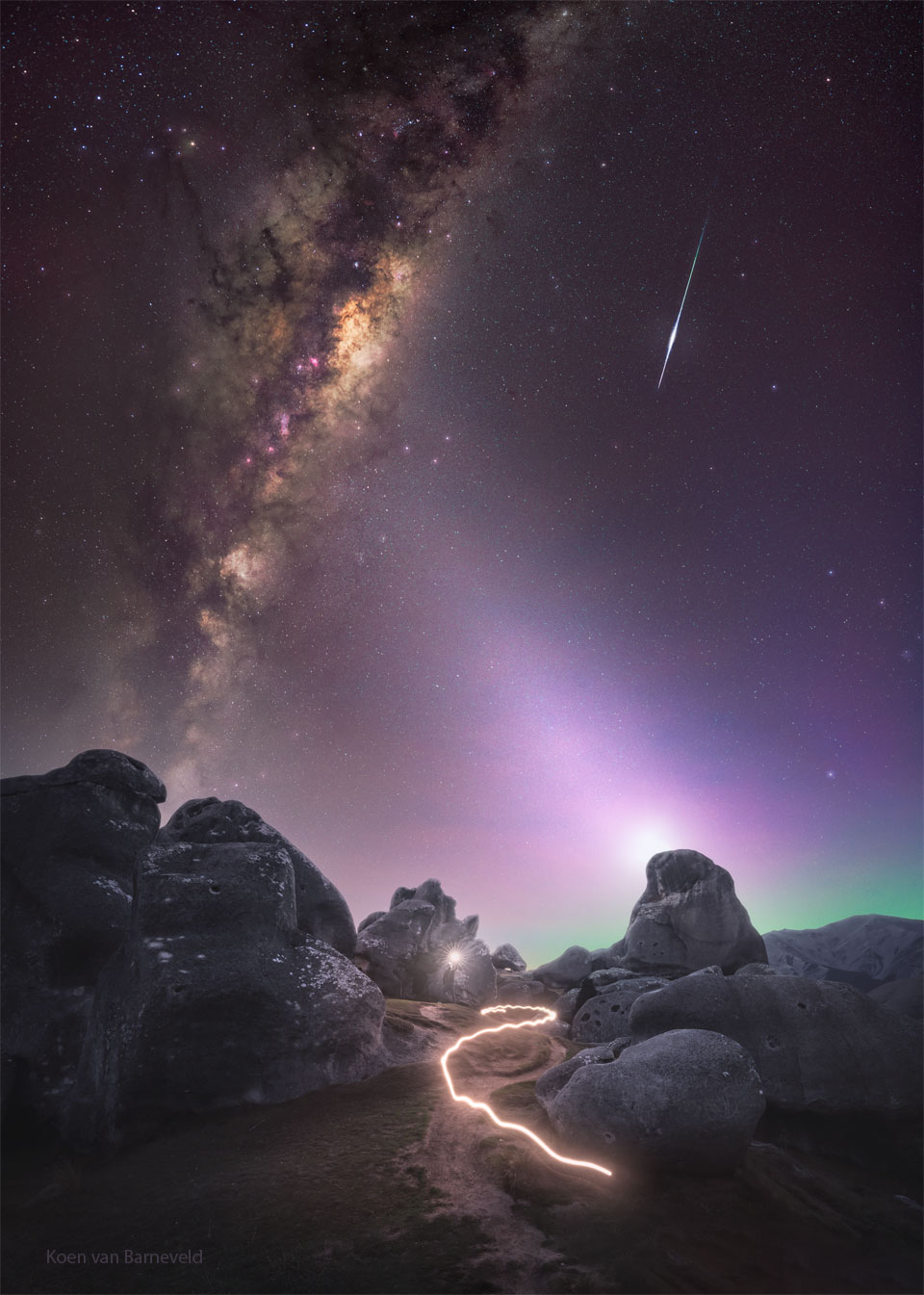Nombre total de pages vues
23/04/2025
SANTé/MEDECINE - Traitement du cancer du poumon (Nouvelles perspectives) - Sensibilisation et politiques alimentaires (7/8)
ASTRONOMY - An Almost Everything Sky
2025 April 23
Image Credit & Copyright: Koen van Barneveld
Explanation: This surprising sky has almost everything. First, slanting down from the upper left and far in the distance is the central band of our Milky Way Galaxy. More modestly, slanting down from the upper right and high in Earth's atmosphere is a bright meteor. The dim band of light across the central diagonal is zodiacal light: sunlight reflected from dust in the inner Solar System. The green glow on the far right is aurora high in Earth's atmosphere. The bright zigzagging bright line near the bottom is just a light that was held by the scene-planning astrophotographer. This "almost everything" sky was captured over rocks on Castle Hill, New Zealand late last month. The featured finished frame is a combination of 10 exposures all taken with the same camera and from the same location. But what about the astrophotographer himself? He's pictured too -- can you find him?
22/04/2025
SANTé/MEDECINE - Traitement du cancer du poumon (Nouvelles perspectives) - Vers des thérapies ciblées (6/8)
LA TERRE VUE DU CIEL - Province de XinJiang en Chine vue de l'espace
CRIMINOLOGIE : l'ADN, un outil pour la police scientifique et la justice
ASTRONOMY - Terminator Moon: A Moonscape of Shadows
2025 April 22
Image Credit & Copyright: Rich Addis
Explanation: What's different about this Moon? It's the terminators. In the featured image, you can't directly see any terminator -- the line that divides the light of day from the dark of night. That's because the featured image is a digital composite of many near-terminator lunar strips over a full Moon. Terminator regions show the longest and most prominent shadows -- shadows which, by their contrast and length, allow a flat photograph to appear three-dimensional. The overlay images were taken over two weeks in early April. Many of the Moon's craters stand out because of the shadows they all cast to the right. The image shows in graphic detail that the darker regions known as maria are not just darker than the rest of the Moon -- they are also flatter.
21/04/2025
SANTé/MEDECINE - Traitement du cancer du poumon (Nouvelles perspectives) - un lien surprenant révélé par des chercheurs (5/8)
ASTRONOMY - Galaxy Lenses Galaxy from Webb
2025 April 21
Image Credit: ESA/Webb, NASA & CSA, G. Mahler
Explanation: Is this one galaxy or two? Although it looks like one, the answer is two. One path to this happening is when a small galaxy collides with a larger galaxy and ends up in the center. But in the featured image, something more rare is going on. Here, the central light-colored elliptical galaxy is much closer than the blue and red-colored spiral galaxy that surrounds it. This can happen when near and far galaxies are exactly aligned, causing the gravity of the near galaxy to pull the light from the far galaxy around it in an effect called gravitational lensing. The featured galaxy double was taken by the Webb Space Telescope and shows a complete Einstein ring, with great detail visible for both galaxies. Galaxy lenses like this can reveal new information about the mass distribution of the foreground lens and the light distribution of the background source.
20/04/2025
LA TERRE VUE DU CIEL - Les géoglyphes de Nazca au Pérou
ASTRONOMY - STEVE: A Glowing River over France
2024 October 28 STEVE: A Glowing River over France Credit & Copyright: Louis LEROUX-GÉRÉ Explanation: Sometimes a river of hot gas flo...

-
2022 September 26 All the Water on Planet Earth Illustration Credit: Jack Cook, Adam Nieman, Woods Hole Oceanographic Institution ; Data ...
-
2021 August 11 Mammatus Clouds over Saskatchewan Image Credit & Copyright: Michael F Johnston Explanation: When do cloud bottoms appe...








